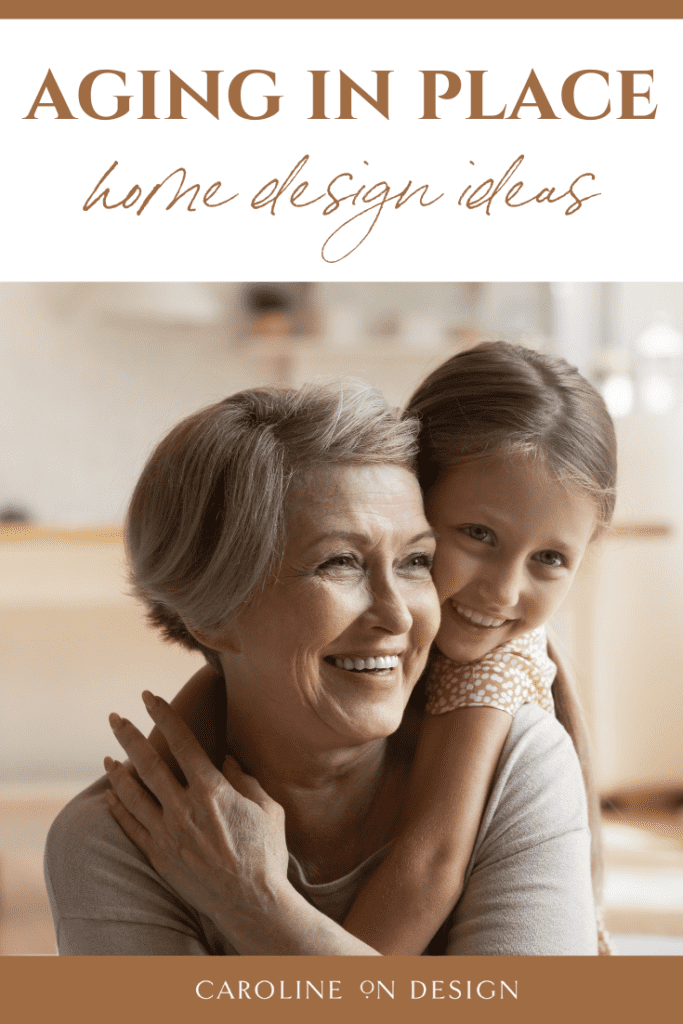One question I get over and over from clients inside my private ‘Before You Build’ home build prep group coaching program is how to plan for ageing in place features when building a home.
In full transparency, I had never heard the term ‘aging in place’ before starting my membership program. However, I am now pretty well versed on ageing in place features and find some of these ideas to be beneficial for any family … regardless of age or ability.
Whether you’re at retirement age or you’re a young family with older parents who need to feel safe and comfortable when they come to visit, you should consider adding aging in place features when designing your home. Not to mention, if you consider this your ‘forever’ home, you’ll want to create a functional home that will work for your family now as well as in the future.
In this blog post, we’ll discuss what ageing in place means as well as what home design elements to consider when you design a home for your future safety needs so that you can remain in your home as long as possible.

Like I said above, this topic of ageing in place is one of the top questions my clients in my ‘Before You Build’ (BYB) Home Build Prep Program ask about.
Several of my BYB clients are at retirement age and building their forever home. Their goal is to live comfortably in their home for as long as possible (no matter what health conditions or needs they will have as they begin to age).
I also have many members with young families who are planning for their future needs as well as creating a safe and comfortable environment for their older parents when they come to visit.
We also have members with children who have disabilities who want to build a home that can accommodate anyone, regardless of ability.
WHAT IS AGEING IN PLACE?
Please note that I use the spellings ‘ageing in place’ and ‘aging in place’ interchangeably as people spell it both ways and I want to reach people who spell it either way :).
The CDC defines ‘aging in place’ as ‘the ability to live in one’s own home and community safely, independently, and comfortably, regardless of age, income, or ability level.’
Ageing in place is based on the concept of ‘Universal Design’ … which refers to designing spaces that can be accessed and comfortably used by anyone, regardless of age or ability.
Universal design takes into account how to design functional (yet aesthetically pleasing) spaces for ALL people.
AGING IN PLACE HOME DESIGN: THINGS TO CONSIDER
Designing your home for the future allows you, the homeowner, to safely and independently live in your home for as long as possible.
There are MANY things to consider when designing your home for aging in place, and it’s up to YOU how much you want your home to be designed for your future needs vs. your present needs.
For example, adding lower sinks in your bathroom will be great in the future if you require a wheelchair for mobility; however, it might be not so great in the present because you’ll have to bend over more and this can be hard on your back.
Another example is that a higher wall oven might be great in the present so you don’t have to bend over as much; however, this will become a problem in the future if you are in a wheelchair and require a lower oven. These are just things to think about.
Below is a list of many important things to consider when designing your home for the future. This is not an exhaustive list of every single thing to think about, but it will certainly get you started and get your wheels turning.
I’ve listed items that are easiest to incorporate when building a home. I didn’t add considerations that be easily implemented later in life such as avoiding area rugs to avoid slipping hazards.
Also, I’ve given the bathroom its own section because your bathroom is the place where most accidents can easily happen.
Here we go …
KITCHEN CONSIDERATIONS
- Add full-extension pull-out drawers in lower cabinets (and under sink) to avoid the need to bend over
- Add space in your lower cabinets for everyday items that would typically go in upper cabinets (e.g. plates and cups)
- Place double-wall ovens at a height where you can access them with little to no bending over (however, this could be a problem if you require a wheelchair in the future)
- Use front-mounted controls on your cooktop and vent hood for easy access
- Consider rounded countertop edges to avoid hurting self on a sharp corner
- Install your microwave at counter height for easy access if you are in a wheelchair
- All kitchen appliances and your sink should be accessible from chair height
- Add plenty of space around your island to maneuver a wheelchair
- If you don’t plan to have a walk-in pantry, install pull-out drawers to make it easy to access pantry items
- The lowest shelves of your upper cabinets should be no higher than 48”, and upper cabinets should be mounted 15” above your countertop
- Your dishwasher should be mounted at least 6” from the floor and it’s best to have the drawer style dishwasher as opposed to the hinged door dishwasher style
WHEELCHAIR ACCESSIBILITY
- A single-story house is optimal for accessibility (however, you have the option to add a chair lift or elevator)
- Doorways should be at least 36” wide and hallways should be at least 42” wide
- Be sure to design your exterior in a way that allows you the ability to add a wheelchair ramp on the outside of your home if needed in the future
- Exterior doors should have a sloped threshold that is no higher than .5” from the bottom of the door
- All flooring transitions (e.g. from one room to the next) should be flush (no saddles)
- Your entire home should be designed to be wheelchair and walker accessible
- Be sure your garage door height is high enough to allow an accessible van to clear the top
- Kitchen counters and sinks should be wheelchair height (however, this could be a problem in the meantime before a wheelchair is needed because it will require you to bend over more)
OTHER CONSIDERATIONS
- Consider how future arthritis in your hands will affect your hand mobility; choose doorknobs and cabinet handles that can be easily accessed if you have arthritis (psst … door levers are easier to grasp than doorknobs)
- All doorway thresholds in your home should be no higher than 0.5” (and flush is ideal)
- All door handles should be mounted no higher than 36”
- Light switches should be easy to use, illuminated, and installed 42” from the floor
- Wall outlets should be about 32-36” from the floor for easy accessibility
- An open concept floor plan allows for easier access in a wheelchair because there are less obstructions
- All closets should be easy to open and maneuver around (if a walk-in closet); closet rods and shelving should be accessible from within 48” above the floor (plus shelves should be no than 18” deep)
- Avoid carpet (if possible) or choose a low pile carpet that a wheelchair can glide over
- Consider a front-load washer and dryer that is raised about 12-15” from the floor
- Window sills should be no higher than 30” from the floor and window controls should be no higher than 24” from the floor
- Install a doorbell that is loud enough to be heard throughout the home (or use a doorbell that can ring on your smartphone)
- Consider adding smart technology to avoid the need to move around unsafely when you need to adjust your thermostat, turn on light or any number of other household tasks that can be done via a phone (bonus … your loved ones can monitor your safety through motion sensors and can track your movements to ensure you are safe and sound if you live alone).

AGE IN PLACE BATHROOM DESIGN
I’m devoting an entire section to aging in place bathroom design features because the bathroom is a place where accidents can most easily happen.
It’s VERY important to really consider how to design your bathroom in a way that is as safe as possible for you as you age in the future.
- Consider a zero-entry shower entrance (or at least a VERY low edge); ideally, showers should be free of doors and curbs at the entrance
- Shower faucet controls should have an adjustable-height showerhead as well as a handheld shower wand that can be accessed next to the shower seat
- Shower stalls should have at least 32” of clearance at the entrance
- Install anti-slip coating in your shower stall (and your bathtub, if applicable)
- Install grab bars in your shower stall (and your bathtub, if applicable) and on both sides of your toilet; If you don’t want to add these unsightly grab bars when you build your home (because you don’t yet need them), be sure your builder puts blocking in when the studs are installed so you will have the ability to accommodate for grab bars in the future
- If possible, install slip-resistant flooring in all bathrooms
- Your toilet seat should be about 18” high and include grab bars on both sides of the toilet
- The path to your toilet should be at least 36” wide
- Sink faucets should be single-lever and easy to operate with one hand (or hands-free); be sure to include a pull out spray head as well
- Add legroom under your vanity counters and sinks for wheelchair accessibility; also, you need plenty of clearance in front of your sink for accessibility
- Your towel bars should be accessible from a wheelchair and should be installed no more than 36” above the floor
NEXT STEPS …
If you are anything like the clients inside my private group coaching program, ‘Before You Build’, designing your future home for ageing in place is a must-have when it comes to safety and functionality.
As I said above, the lists in this blog post don’t include every single feature, but there are certainly enough ideas to get you thinking about how to create the safest, most functional, and most comfortable environment for your family now as well as in the future as your health needs change.
These lists will get you started on your path to planning your future home, but there is soooo much that goes into planning for a successful home build … and my mission is to simplify the home build process for YOU!
Soooo … I’ve created a *FREE* Custom Home Build Prep Guide for you that will help you prepare to build your dream home (that is perfect for your family both now and in the future) with more confidence, less stress, and a strategic plan to stick to budget.
